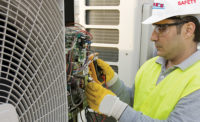It takes a special set of skills and passion for a contractor to become an expert in hydronic systems. Two contractors who fit this mold are Paul Shay and Dan Foley. Shay is in New York City, and Foley is based near Washington, District of Columbia. Once these guys get started talking about their work, it’s hard to get them to stop.
And it’s worth listening to their stories, according to Dan Holohan, owner of HeatingHelp.com.
“Paul Shay focuses on the old loft buildings in lower Manhattan. He puts these systems back to the way they were in the 1890s with amazing results,” Holohan said. “And Dan Foley does amazing work in some of the grandest homes I’ve ever visited.”
From ROI to Love
Shay is owner of A Real Good Plumber Inc. in Brooklyn, New York, where he and his 17 employees provide heating, plumbing, and sprinkler services. When asked if the majority of his work is commercial or residential, he responded: “In New York City, it’s a complicated question. I almost only work on places where people live … but it’s mostly 10-family to 100-family multiple dwellings.” And, he added, “Some of the situations I see are quite unusual, strange, and old.”
There’s very little forced-air equipment in Shay’s neck of the woods, but lots of steam and hot water systems. “The systems are there, they’ve been there for a long time, and it’s expensive to go in and change the infrastructure,” he said.
This is why much of his work is focused on restoring systems and enhancing their efficiencies.
“What’s cool around New York City is that it’s not hard to offer and deliver ROI [return on investment],” he said. “It’s not uncommon for me to go out to someone, ask them to spend $90,000, and they get their money back in four years.”
As a typical example of the work he does, Shay said: “When we go into a building with a hot water system, we take out a standard-efficiency 80 percent boiler and we put in a 95-96 percent condensing boiler. And it’s not just about the 15 percent efficiency — it’s about cutting fuel bills in half.”
He added, “I’m big on condensing boilers, and my favorite boiler is the Lochinvar, in terms of efficiency and just the fact that it doesn’t break down and it goes up to 160 pounds of pressure.”
Shay also noted he uses Aquatherm piping for hydronic systems, which is recyclable polypropylene piping that he said, “will last forever and is so cool you just can’t believe it.”
Shay also has extensive experience with 1- and 2-pipe steam systems, many of which have not been well maintained before he is called onto the scene.
In the simplest terms, Shay said, “My basic rule on a 1-pipe system is vents all over the place. With 2-pipe steam, I’m an orifice person.”
One current project his crew is working on is a 27-story building with 2-pipe steam where the plan is to put orifices on all 400-plus radiators.
“No condensate trap will last more than five years, they’re more expensive, and you have to do them all at once,” Shay said, explaining his reasoning behind this approach. “Orifices are much cheaper, can be done quicker, and last forever. It basically restricts the flow of steam into a radiator, and if you don’t let too much steam get into a radiator, then there’s no steam to get into the return line. It’s kind of that simple, though you do have to maintain your pressure very well.”
Of course, Shay acknowledged, “When I started out, I didn’t know what I know now.” He is grateful that he has always had the ability to “read a book and apply it.” And he also credits his membership in the Nexstar Network for introducing him to great people and ideas. Nowadays, he focuses more than ever on passing his knowledge on to others.
“I’m a big believer in getting junior guys — they want to learn. I’m a big teacher, so it’s a perfect match,” he said.
Over the years, Shay said he has become a believer that great leaders lead with love. He tries to focus on teaching — not just disciplining — his employees.
“Love your product, love your people, love your customers, and you’ll get where you don’t want to retire or quit,” he said.
Simple Design, Standout Work
Foley is president of Foley Mechanical in Lorton, Virginia, which he established in 2002. As his company has grown, he has developed a specialty in designing hydronic systems for large custom homes in the Washington metro area. And he is very passionate about his craft.
“I want my work to standout,” he said. “I want it to be the best. When I design systems, it’s a three-legged stool. It’s got to be efficient, comfortable, and — the third leg, which people leave out sometimes — reliable.”
According to Foley, the best design for a system that achieves these three goals is always the simplest. “It’s easy to design a Rube Goldberg system,” he said. “I’m the reverse — I want it to be simple. When you walk into a boiler room, simplicity and reliability go hand in hand. And that’s where the skill comes in, to try to design something that’s complicated by nature and make it simple, make it reliable.”
Foley interacts mostly with the architects when working on custom homes and said he has earned a reputation with them that allows him “a blank canvas to design the mechanical system.”
For example, he said, if there’s a lot of glass, “I tell them we need radiant, and an architect is going to take my recommendation.”
Foley also stressed the myth that radiant floor heat is too expensive is just that — a myth. While it can be expensive, he noted it can also be functional and economical.
“A growing niche for us is radiant cooling,” he said. “I’ve done radiant heating for 20 years, but radiant cooling is relatively new for us.”
Since the majority of Foley’s work is custom, it’s almost impossible for him to describe a typical project. He noted that past and current projects have included everything from geothermal systems to radiant floor heat to high-efficiency condensing boilers to chillers.
Foley is happy with his current workload and roster of 17 employees, but is concerned about where the industry’s future workers will come from.
“The biggest challenge is finding skilled, qualified people to work for you,” he said. “You need to have heat, and you need skilled people to work on those systems. You can’t be stupid and be in this trade.”
The message he hopes to share is that true passion and pride can be found in this trade.
“The joy comes from creating something. It’s not an abstract — we’re physically building something with our hands, and, when we’re done, we flip the switch and things happen,” Foley said.
Publication date: 10/27/2014
Want more HVAC industry news and information? Join The NEWS on Facebook, Twitter, and LinkedIn today!















